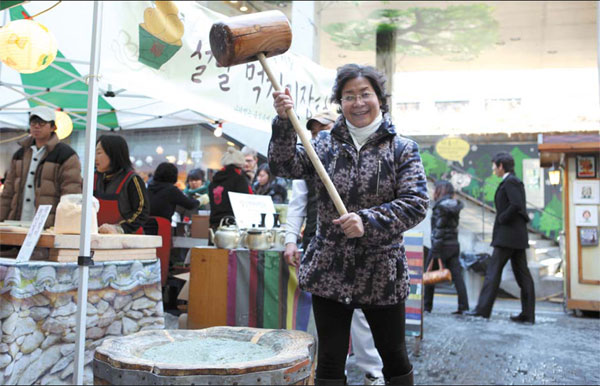Chinese tourists favor holidays in ROK
 0 Comment(s)
0 Comment(s) Print
Print E-mail China Daily, June 28, 2013
E-mail China Daily, June 28, 2013
|
|
|
A tourist from China cooks a local food Dagao at Insadong, a cultural street with a mix of art galleries, cafes and restaurants in Seoul. Today, more and more Chinese view the ROK as a top destination for sightseeing and shopping in Asia. [China Daily] |
China is expected to overtake Japan as the largest source of foreign tourists to the Republic of Korea, according to a major local newspaper.
The Chosun Ilbo reported in June that the country received 868,000 Chinese tourists and 870,000 Japanese in the first four months of this year.
Although Japan still led by a narrow margin, the number of its tourists dropped 23.5 percent from the previous year, while the number of Chinese surged 54 percent year-on-year, according to the report.
The newspaper reported when statistics come out for May, Chinese are expected to account for the lion's share of foreign visitors because China's three-day May Day holiday falls in that month.
Statistics from the Korea Tourism Organization shows that about 2.83 million Chinese tourists went to the ROK in 2012, an increase of 28 percent from 2011.
The organization predicts that the number could reach 3.2 million this year.
Qi Jinhai, general manager of Beijing Guangshun International Travel Agency, said his company usually arranges 1,000 to 2,000 self-guided tours to the country every month now.
The most popular destinations include Jeju Island and the capital Seoul.
A volcanic island off its southern coast, Jeju is the hottest honeymoon destination in the country and is considered the country's equivalent of Hawaii.
By the end of 2012, the island had received more than 1.5 million tourists, and 1 million of them are from China, reported The Chosun Ilbo. "Chinese people are more affluent today," Qi said this has led them to travel more.
He said the company is also preparing a new translation service via an online instant messaging application on smartphones for self-guided visitors.
"It will be like having a private interpreter and guide around you and will facilitate in-depth tours for individual visitors," Qi said.
In addition to sightseeing, many visitors go to the ROK for shopping, wedding photos, health exams, and cosmetic surgery, he said.
The JoongAng Ilbo, another local newspaper, reported in April that a survey of 1,423 clinics in the country shows 15,000 foreigners, 63 percent of whom were Chinese, received plastic surgery in 2012.
According to the report, the major sources of medical tourists to the country are China, the US, Japan, Russia and Mongolia.
Tian Youguo, general manager of Beijing Best Trip Service Co Ltd, a travel agency that specializes in tours to Japan and the ROK, said that in the first five months of this year, about 8,000 visitors went to the country through trips organized by his company.
He said the business will get even better later in the year because July and August are the peak tourism periods.
"Every year, there are more and more Chinese visitors going to the ROK mainly because of the simplified visa application procedure and the increasing number of flights between the two countries," he said.
"Almost every provincial capital now has direct flights to the country."
The Chosun Ilbo reported that 2.2 million Chinese people traveled to the ROK by plane last year, more than double the figure in 2009.
Hainan Airlines said each month it flies around 1,500 Chinese travelers to the country.
It now has three direct flights per week from Beijing to Busan, the second-largest city in the country.
The airline expects a steady increase in the number of tourists to the ROK as local authorities know the importance of the Chinese people to its tourism industry.
Korean Air, the country's largest airline, will launch four flights per week from Nanjing, capital of East China's Jiangsu province, to Busan and increase the number of flights from Jinan, capital of East China's Shandong province, to Seoul from four to seven per week since July due to rising demand, said the company.
Now the company operates 236 flights per week between the two countries, and the number will increase to 243, it added.
To generate interest among Chinese tourists, the Korea Tourism Organization has been staging a series of events in the past few weeks throughout the nation. One is the traditional musical Miso. Staged in Beijing on June 22, it attracted a number of fans to line up outside the Guo'an Theatre to experience the performance, which not only showcases traditional Korean narrative songs but also presents a variety of other traditional instrumental performances, including Korean fan dances.
Organizers said Miso is a must-see performance in the country for overseas visitors and has attracted about 850,000 viewers since its launch in 1997 at the Chongdong Theater in Seoul. The organization's tourism campaign featuring pop singer Psy called Wiki Korea has also gone online in China.
The one-and-a-half minute advertisement highlights the most popular tourism activities including shopping, eating, outdoors, and nightlife.
A popular hip-pop singer from the country, Psy rose to instant fame with his song Gangnam Style in 2012.







Go to Forum >>0 Comment(s)